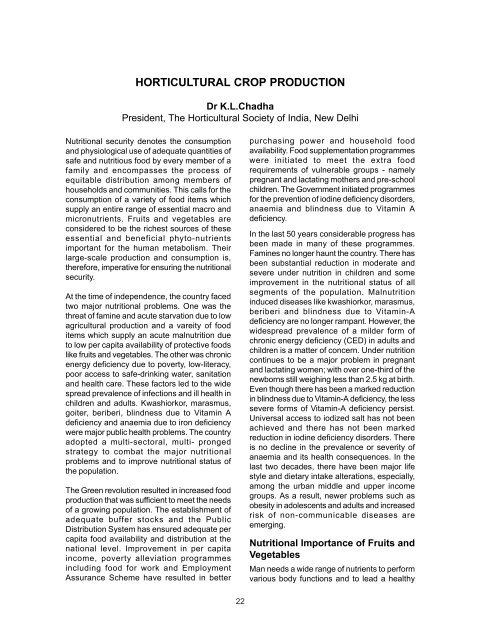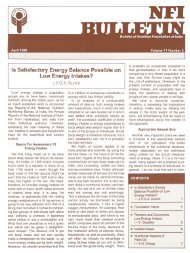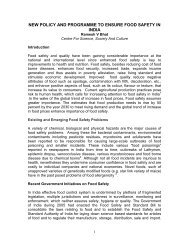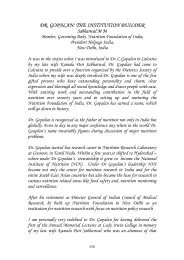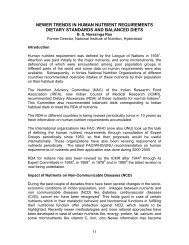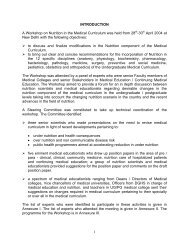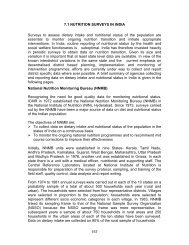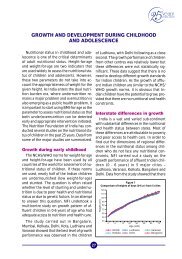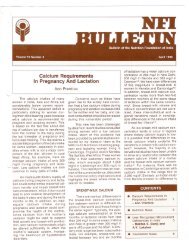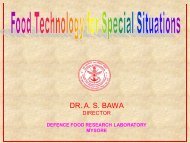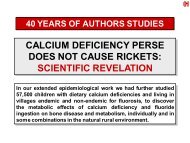horticultural crop production - Nutrition Foundation of India
horticultural crop production - Nutrition Foundation of India
horticultural crop production - Nutrition Foundation of India
You also want an ePaper? Increase the reach of your titles
YUMPU automatically turns print PDFs into web optimized ePapers that Google loves.
HORTICULTURAL CROP PRODUCTIONDr K.L.ChadhaPresident, The Horticultural Society <strong>of</strong> <strong>India</strong>, New Delhi<strong>Nutrition</strong>al security denotes the consumptionand physiological use <strong>of</strong> adequate quantities <strong>of</strong>safe and nutritious food by every member <strong>of</strong> afamily and encompasses the process <strong>of</strong>equitable distribution among members <strong>of</strong>households and communities. This calls for theconsumption <strong>of</strong> a variety <strong>of</strong> food items whichsupply an entire range <strong>of</strong> essential macro andmicronutrients. Fruits and vegetables areconsidered to be the richest sources <strong>of</strong> theseessential and beneficial phyto-nutrientsimportant for the human metabolism. Theirlarge-scale <strong>production</strong> and consumption is,therefore, imperative for ensuring the nutritionalsecurity.At the time <strong>of</strong> independence, the country facedtwo major nutritional problems. One was thethreat <strong>of</strong> famine and acute starvation due to lowagricultural <strong>production</strong> and a vareity <strong>of</strong> fooditems which supply an acute malnutrition dueto low per capita availability <strong>of</strong> protective foodslike fruits and vegetables. The other was chronicenergy deficiency due to poverty, low-literacy,poor access to safe-drinking water, sanitationand health care. These factors led to the widespread prevalence <strong>of</strong> infections and ill health inchildren and adults. Kwashiorkor, marasmus,goiter, beriberi, blindness due to Vitamin Adeficiency and anaemia due to iron deficiencywere major public health problems. The countryadopted a multi-sectoral, multi- prongedstrategy to combat the major nutritionalproblems and to improve nutritional status <strong>of</strong>the population.The Green revolution resulted in increased food<strong>production</strong> that was sufficient to meet the needs<strong>of</strong> a growing population. The establishment <strong>of</strong>adequate buffer stocks and the PublicDistribution System has ensured adequate percapita food availability and distribution at thenational level. Improvement in per capitaincome, poverty alleviation programmesincluding food for work and EmploymentAssurance Scheme have resulted in betterpurchasing power and household foodavailability. Food supplementation programmeswere initiated to meet the extra foodrequirements <strong>of</strong> vulnerable groups - namelypregnant and lactating mothers and pre-schoolchildren. The Government initiated programmesfor the prevention <strong>of</strong> iodine deficiency disorders,anaemia and blindness due to Vitamin Adeficiency.In the last 50 years considerable progress hasbeen made in many <strong>of</strong> these programmes.Famines no longer haunt the country. There hasbeen substantial reduction in moderate andsevere under nutrition in children and someimprovement in the nutritional status <strong>of</strong> allsegments <strong>of</strong> the population. Malnutritioninduced diseases like kwashiorkor, marasmus,beriberi and blindness due to Vitamin-Adeficiency are no longer rampant. However, thewidespread prevalence <strong>of</strong> a milder form <strong>of</strong>chronic energy deficiency (CED) in adults andchildren is a matter <strong>of</strong> concern. Under nutritioncontinues to be a major problem in pregnantand lactating women; with over one-third <strong>of</strong> thenewborns still weighing less than 2.5 kg at birth.Even though there has been a marked reductionin blindness due to Vitamin-A deficiency, the lesssevere forms <strong>of</strong> Vitamin-A deficiency persist.Universal access to iodized salt has not beenachieved and there has not been markedreduction in iodine deficiency disorders. Thereis no decline in the prevalence or severity <strong>of</strong>anaemia and its health consequences. In thelast two decades, there have been major lifestyle and dietary intake alterations, especially,among the urban middle and upper incomegroups. As a result, newer problems such asobesity in adolescents and adults and increasedrisk <strong>of</strong> non-communicable diseases areemerging.<strong>Nutrition</strong>al Importance <strong>of</strong> Fruits andVegetablesMan needs a wide range <strong>of</strong> nutrients to performvarious body functions and to lead a healthy22
life. Carbohydrates, proteins, fats, minerals andvitamins constitute most <strong>of</strong> the foods that weconsume. If we analyze the chemicalcomposition <strong>of</strong> a healthy man weighing 65 kg,a major proportion <strong>of</strong> it comprises <strong>of</strong> water (61.6percentage) followed by protein (17%), fat(13.8%) and carbohydrates (1.5%).Energy needs are mainly derived fromcarbohydrates and fats. Animal products andpulses supply the required proteins while fruitsand vegetables supply the required vitamins andminerals. A study <strong>of</strong> the recommended dietaryallowance (RDA) indicates that an adolescentrequires 3000 k calories <strong>of</strong> energy, proteins (55g), Calcium (0.5 to 0.6 g), iron (25 mg), retinol(750 µg) and thiamin (1.5 mg) in addition to anumber <strong>of</strong> other vitamins. Rib<strong>of</strong>lavin (1.7 mg),nicotinic acid (21 mg), ascorbic acid (30 to 50mg), folic acid 50 to 100 µg, vitamin B 12(0.5 to1 µg), vitamin D (200 I.U.) and β carotene (3000µg) are also necessary. These dietaryrequirements can be met through a balanceddiet comprising <strong>of</strong> cereals (500 g), pulses (75g), fruits (120 g), milk (200 ml), leafy vegetables(125 g) other vegetables (80 g), roots and tubers(90 g), fats and oils (40 g) and sugar (40 g). Inorder to ensure a balanced diet, the diet shouldconstitute <strong>of</strong> 25 to 30% <strong>of</strong> fruits and vegetables.Fruits and vegetables form the second mostimportant constituent in USA after cereals.Fruits and vegetables can play a unique role inmeeting the nutritional needs <strong>of</strong> our population.Taken fresh or in processed form, they not onlyimprove the quality <strong>of</strong> our diet but also provideessential ingredients like carbohydrates,proteins, fats, vitamins and minerals.Horticultural <strong>crop</strong>s rich incarbohydratesCarbohydrates are the building blocks <strong>of</strong> humanbody. They provide the ready energy in the form<strong>of</strong> sugars. Nearly 60% <strong>of</strong> a standard mealcomprises <strong>of</strong> carbohydrates and (vitamins,minerals and sugars) contribute the rest.Bael fruitUnripe or half ripe fruit contains 31.3%-31.8%carbohydrates, 1.8% proteins and 2.9% fibre.It is also rich in minerals and vitamins. Its highvitamin C contents can overcome scurvy, whichis caused by vitamin C deficiency.BananaThe ripe fruit contains 20% <strong>of</strong> carbohydrates,rich content <strong>of</strong> potassium, iron and fair amounts<strong>of</strong> vitamin B and calcium. It is an important fruit<strong>of</strong> <strong>India</strong> with the largest area and <strong>production</strong>.Even though <strong>India</strong> is the largest producer <strong>of</strong>banana fruit in the world with a total <strong>production</strong><strong>of</strong> 15.07 million tones, our per capita availability<strong>of</strong> banana is less than 1.5. kg/person/year. In<strong>India</strong>, fruits <strong>of</strong> some cultivars <strong>of</strong> banana likeNendran are also used for breakfast aftersteaming while banana chips are an importantsubsidiary food item in several Southern andWestern <strong>India</strong>n states.CassavaIt is the richest source <strong>of</strong> carbohydrates andserves as a staple food in a number <strong>of</strong>underdeveloped countries. It produces about25,00,00 calories <strong>of</strong> energy/ha compared to11,00,00 calories from wheat and 17,60,00calories from rice. In areas with no ricecultivation, it is used as a staple diet for the poor.It plays a major role in averting famines arisingfrom food scarcity. Further, there has beenreduction in cassava consumption and<strong>production</strong> due to changes in food consumptionpatterns during the ‘Green Revolution’. Cassavaalso continues as the unchallengedmonopolized raw material for sago <strong>production</strong>in <strong>India</strong> and presently there are more than athousand industrial units in Tamilnadu. On aglobal basis, tuber <strong>crop</strong> is an importantsubsidiary food after cereals and grain legumes;it produces the highest rate <strong>of</strong> dry matter perday and is a major energy contributor. Most <strong>of</strong>the tuber <strong>crop</strong>s have wide adaptability and canproduce economic yields in marginal landsunder varied agro-climatic conditions. Tomaintain rhythm in the supply <strong>of</strong> food materialsand to keep pace with the increasing population,food <strong>crop</strong>s like cassava will have to be retainedwithin the <strong>crop</strong>ping pattern <strong>of</strong> the marginalfarmers.DatesThe fruits are very rich in carbohydrates, mostlyin the form <strong>of</strong> invert sugars (75 to 80%),phosphorus, potassium and iron.23
GrapesBoth fresh grapes and dried raisins are a goodsource <strong>of</strong> energy due to high proportions <strong>of</strong>reducing sugars. The fruits are good sources<strong>of</strong> calcium, phosphorus, iron, tartaric acid andpectin. Traces <strong>of</strong> iodine and fluoride are als<strong>of</strong>ound in the fruits.JackfruitIt supplies a significant quantity <strong>of</strong> energy as itcontains 20% <strong>of</strong> carbohydrates. The aroma richfruit is a good source <strong>of</strong> protein, fat, β-carotene,thiamine, calcium, iron, potassium, and sodium.PotatoPotato serves as a staple food in a number <strong>of</strong>countries. It possesses 22% <strong>of</strong> carbohydratesand 2% <strong>of</strong> high value protein, in addition totraces <strong>of</strong> vitamins A, B and C. Not only the totalor average yield/kg/ha/day is more in potatowhen compared to rice, wheat or maize but itsdry matter and protein content is also high thanmany other major <strong>crop</strong>s. Energy and proteincontent <strong>of</strong> potato is 678 (10-K cal) and 176 kg,respectively. In comparison, per hectare foodenergy obtained from wheat, rice, maize andsoybean is 394, 688, 458 and 525 Kg,respectively. Another useful feature <strong>of</strong> potatoas a major food <strong>of</strong> the future is versatility <strong>of</strong> itsuses in a variety <strong>of</strong> dishes. Potato is devoid <strong>of</strong>fat and thus, can be consumed in largequantities without running the risk <strong>of</strong> becomingoverweight/obese. An adult male’s total energyrequirement can be met by consuming about3.3 kg <strong>of</strong> boiled potato. Potato is an importanthorticulture <strong>crop</strong> in our country, which can begrown all the year round in one or the other partand in almost all types <strong>of</strong> soils. Potato varietiesare now available, which can fit in both shortand long-day conditions. Potato can be grownwith rice-wheat rotation and can also fit invegetable <strong>crop</strong> sequences or an inter-<strong>crop</strong> withonion, okra, french bean and radish. Potatoconsumption level exceeds 100 kg/year/headin U.K., Poland and Germany. Besides beingnutritious, potato is a socially accepted food. Itcan, thus, form a part <strong>of</strong> our food and nutritionalsecurity programme.Horticultural <strong>crop</strong>s rich in ProteinsProteins are essential for all living processesand carry out a wide range <strong>of</strong> functions. Proteinsupplementation is vital in early childhood toensure complete brain development. On anaverage, 55 to 65 g <strong>of</strong> protein is essential forhealthy human beings. Although fruits andvegetables contain less protein; but theirbiological value is high.AlmondIts kernels are rich in protein (20.8%), fat(59.8%) and carbohydrates (10.5%). It is richin magnesium, copper, manganese and zinc.Cashew nutThe kernels are rich in proteins (21.2%), fats(46.9%) and carbohydrates (22.3%). The kerneloil is set to be more nutritive than olive oil. It is agood source <strong>of</strong> essential amino acids, thiamine,rib<strong>of</strong>lavin and minerals.Horticultural <strong>crop</strong>s rich in fatsFats are concentrated source <strong>of</strong> energy, whichare involved, in a number <strong>of</strong> metabolic functions.Some fruits and nuts are rich sources <strong>of</strong> highquality fats containing essential fatty acids. Inaddition to almond and cashew the following<strong>crop</strong>s contain significant quantities <strong>of</strong> fat.ApricotThe nuts are rich in proteins and oils (40-45%),which is similar to almond oil in terms <strong>of</strong>nutritional qualities. Apricots are rich in iron andare an excellent remedy for anaemia. They arerich in natural sugars, vitamin A rib<strong>of</strong>lavin,niacin, vitamin C and minerals like calcium.AvocadoIt is one <strong>of</strong> the richest sources <strong>of</strong> fat (24.5%)after olive. The fat is <strong>of</strong> high quality and is totallyfree from unpleasant butyric acid. The proteinis <strong>of</strong> finest quality and is far superior to proteinscum-cereals.It is rich in vitamin A and its regularintake <strong>of</strong>fers excellent remedy in acute digestivedisorders.WalnutThe nuts contain 14 to 20% protein and 60 to67% fat, in addition to significant quantities <strong>of</strong>vitamins A and B. The immature fruits are richin ascorbic acid.24
Horticultural <strong>crop</strong>s rich in VitaminsFruits and vegetables are the richest source <strong>of</strong>vitamins. These water soluble and fat-solubleorganic substances facilitate the metabolism <strong>of</strong>fats, amino acids and carbohydrates. Theirdeficiency leads to a number <strong>of</strong> diseases inchildren and adults.Vitamin A (Retinol)Retinol is essential for clear vision in dim light.The deficiency leads to redness, inflammationand gradual loss <strong>of</strong> vision. About 750 µg <strong>of</strong>retinol is required per day for a healthy vision.Fruits and vegetables are rich sources <strong>of</strong> vitaminA, particularly, those containing yellow pigment,β-carotene. Red palm oil is one <strong>of</strong> the richestsources <strong>of</strong> retinol. All leafy vegetables, carrots,fresh apricots, cape gooseberry, ripe mango,orange, raspberry and ripe papaya are also richin retinol. Many ripe yellow fruits (mangoes andpapayas), vegetables (tomatoes, carrots andyellow pumpkins) and tuber <strong>crop</strong>s are richsources <strong>of</strong> carotene. Leafy vegetables likeamaranth, beet leaf, palak, bassela, fenugreek,coriander, drumstick leaves, curry leaves, mint,radish leaves, etc. are rich sources <strong>of</strong> carotene.In general, the darker the green leafy vegetable,the higher the content <strong>of</strong> carotene it has. Thedaily requirement <strong>of</strong> vitamin A for an adult isestimated to be around 600 mg (2000 IU) <strong>of</strong>vitamin A. The requirement <strong>of</strong> vitamin A isrelatively higher during pregnancy, lactation andchild growth. Animal foods rich in vitamin A areexpensive. Hence, the most inexpensive andconvenient way to ensure an adequate intake<strong>of</strong> vitamin A is to include green leafy vegetablesin the daily diet. About 500 gm <strong>of</strong> common leafyvegetables like amaranth will provide adequateβ-carotene to meet the vitamin A requirement<strong>of</strong> an adult.Vitamin A is an important micronutrient formaintaining normal growth, regulating cellularproliferation and differentiation, controllingdevelopment programmes for maintainingvisual and reproductive functions. Vitamin Acannot be synthesized by humans and so mustbe consumed as an essential nutrient in the diet.Over the last two decades, there has been amarked decline in blindness due to vitamin Adeficiency; but dietary intake <strong>of</strong> vitamin A hasremained sub-optimal in the poorer segments<strong>of</strong> the population. As a result, clinical deficiencysigns are being reported among pregnant andlactating women and children even today.Vitamin B ComplexThe B-complex vitamins are essential for properutilization <strong>of</strong> carbohydrates, fats and proteins.The important vitamins, their metabolic role,sources, their requirement is summarized in thefollowing table1.Among the B-vitamins deficiencies, folic acidhas become important not only because <strong>of</strong> its25
problem. <strong>India</strong> is one <strong>of</strong> the countries with thehighest prevalence <strong>of</strong> anaemia. Low dietaryintake and poor iron and folic acid intake aremajor factors responsible for high prevalence<strong>of</strong> anaemia in <strong>India</strong>. Poor bioavailability <strong>of</strong> ironin phytate fibre rich <strong>India</strong>n diet aggravates thesituation. Anaemia due to deficiency <strong>of</strong> othermicronutrients like copper, zinc, pyridoxine andvitamin B12 is rare in <strong>India</strong>.Strategies to ensure <strong>Nutrition</strong>alSecuritySeveral initiatives have been taken to improvehorticulture <strong>crop</strong> <strong>production</strong> and their availability.These include increased budgetary support,development <strong>of</strong> Research and development(R&D) infrastructure, introduction anddevelopment <strong>of</strong> highly nutritive <strong>crop</strong>s, varieties,availability <strong>of</strong> quality planting material andtechnology for higher productivity. These arediscussed below.Budgetary support for InfrastructureDevelopmentHorticultural research and development was atvery low ebb till the 3 rd five-year Plan andreceived meager attention even thereafter.However, the plan investment in <strong>horticultural</strong>R&D increased significantly since the 8 th fiveyearPlan, which resulted in considerablestrengthening <strong>of</strong> the <strong>horticultural</strong> R&Dprogrammes in the country. Separate Planallocation for research on horticulture <strong>crop</strong>s bythe <strong>India</strong>n Council <strong>of</strong> Agricultural Research(ICAR) was first made in 4 th five-year Plan witha modest allotment <strong>of</strong> Rs. 34.8 million. This wasenhanced to Rs. 4080 million during Tenth Plan.At present, allocation for research is about 7.6per cent <strong>of</strong> the total outlay for agriculturalresearch made by the ICAR.The plan allocation for Horticulture developmentalso started with a meager financial allocation<strong>of</strong> Rs. 20.5 million in the 4 th Plan. However, itrose to Rs.76.2 million in 5 th Plan, Rs.146.4million in 6 th Plan, Rs.250 million in 7 th Plan,Rs. 10,000 million in 8 th (utilization Rs.7890million), Rs.21300 million in 9 th Plan and Rs1,00,000 million in Tenth Plan. While theincrease in budgetary allocation from 4 th to tenthPlan was 117 times for research, it was 400times in respect <strong>of</strong> development programmes.Research InfrastructureThe ICAR is the premier agency, whichpioneered systematic research on agricultural<strong>crop</strong>s in the country. Horticulture research in<strong>India</strong> received very little attention till the 3 rd fiveyearplan. The establishment <strong>of</strong> the <strong>India</strong>nInstitute <strong>of</strong> Horticultural Research in Bangaloreand the start <strong>of</strong> eight All <strong>India</strong> Coordinated CropImprovement Projects to cover different<strong>horticultural</strong> <strong>crop</strong>s was a landmark in the history<strong>of</strong> horticulture in IV five year Plan (1969-74).Rapid expansion <strong>of</strong> the infrastructure took placein 7 th and 8 th Plans. Today, the <strong>horticultural</strong>research in the country is being carried out atnine ICAR institutes (with 25 regional stations)and 12 National Research centers, one eachon banana, citrus, grape, onion and garlic,mushroom, orchid, medicinal and aromatic<strong>crop</strong>s, oil palm, seed spices, cashew nut, litchiand makhana besides one full fledged stateuniversity on horticulture at Solan, HimachalPradesh.Area specific, multi-disciplinary research is alsobeing conducted under 14-All <strong>India</strong>Coordinated Research Projects, one each onTropical, Sub-Tropical, Arid Fruits; Vegetables,Potato, Tuber Crops, Mushrooms; OrnamentalCrops, Medicinal and Aromatic <strong>crop</strong>s; Palms,Cashew, Spices and Betel vine. Post HarvestTechnology is being researched in 215 centreslocated at various research institutes, and StateAgricultural Universities. Research onhorticulture is also being undertaken at severalmulti-<strong>crop</strong>, multi-disciplinary institutes.Departments <strong>of</strong> Horticulture in 24 AgriculturalUniversities, one deemed University and onefull-fledged University <strong>of</strong> Horticulture andForestry are also engaged in <strong>horticultural</strong>research. In addition, several network projects,one each on ‘Hybrid research in vegetable<strong>crop</strong>s’, ‘Drip irrigation in perennial <strong>horticultural</strong><strong>crop</strong>s’, ‘Protected cultivation <strong>of</strong> ornamental<strong>crop</strong>s’ and ‘Phytophthora disease <strong>of</strong> horticulture<strong>crop</strong>s’ are now in operation. In addition to 280adhoc schemes supported from AgricultureProduce Cess Fund; a number <strong>of</strong> foreign-aidedprojects have also been in operation on specificproblems in different horticulture <strong>crop</strong>s. As a27
esult, the country now has a sound researchinfrastructure in horticulture to meet the growingneeds and expectations <strong>of</strong> the fast developingindustry.Development InfrastructureThe Department <strong>of</strong> Agriculture and Cooperationin the Ministry <strong>of</strong> Agriculture is the nodaldepartment for horticulture development in thecountry. It has directorates, one each onCashew nut and Cocoa and Arecanut andSpices located in Cochin and Calicut (Kerala)besides three autonomous boards, NationalHorticulture Board, Coconut DevelopmentBoard and Bee Keeping Board in the Ministry<strong>of</strong> Agriculture. In addition, the Ministry <strong>of</strong>Commerce has been promoting research;development and exports <strong>of</strong> cardamom, throughthe Commodity Boards set up for that verypurpose - namely Spices Board, Tea Board,C<strong>of</strong>fee Board and Rubber Board respectively.Also, an Agriculture Produce ExportDevelopment Authority (APEDA) has been setup under the aegis <strong>of</strong> the Commerce Ministryto promote the export <strong>of</strong> <strong>horticultural</strong>commodities both fresh as well as value addedproducts. Indirect organizational support forhorticulture development is also being providedby two agencies in the Ministry <strong>of</strong> Agriculture,namely, the National Cooperative DevelopmentCorporation (NCDC) and the NationalAgricultural Cooperative Marketing Federation(NAFED) and its institute, the NationalHorticultural Research and Development<strong>Foundation</strong> (NHRDF).Increasing the Availability <strong>of</strong> NutritiveFruits and VegetablesIntroduction and cultivation <strong>of</strong>nutritive <strong>crop</strong>sSeveral new <strong>crop</strong>s, rich in nutritional value, havebeen introduced for commercial cultivation, e.g.:Kiwi fruit in the sub-mountain areas <strong>of</strong> North<strong>India</strong>, olives in the mid hills <strong>of</strong> the North WesternHimalayas, low chilling stone fruits in the NorthWestern plains, oil palm in some coastal states,gherkin in south and west <strong>India</strong>, baby corn andsweet corn in specific pockets and broccoli,brussel sprouts, asparagus, celery and parsleynear the cities.Identification / Development <strong>of</strong>nutritionally rich varieties andTechnologiesFruit CropsA large number <strong>of</strong> high yielding varieties havebeen developed in several <strong>horticultural</strong> <strong>crop</strong>s.In fruits alone 123 varieties have beendeveloped in 12 <strong>crop</strong>s e.g. aonla (10), acid lime(4) apple (8), banana (5), custard apple (1),grape (13), guava (13), litchi (4), mango (28),papaya (17), pomegranate (11) and sapota (9).The attributes <strong>of</strong> some varieties in different<strong>crop</strong>s are larger fruits, high yielding aonla,bananas resistant to sigatoka disease, custardapple with a high pulp percentage, grapevarieties suitable for raisin making, less and s<strong>of</strong>tseeded guava, early bearing litchi, regularbearing semi dwarf mango, gynodioeciousvarieties in papaya and pomegranate with s<strong>of</strong>tand red colored aril.Almond varieties with thin shells have beenidentified for large scale cultivation.Aonla has become very popular in the aridzones <strong>of</strong> our country due to its high nutritivevalue and ability to grow in marginal soils. Areasunder aonla have been steadily increasing instates like Rajasthan, Uttar Pradesh, Gujarat,Andhra Pradesh, Tamil Nadu and Karnataka.Improved propagation techniques helped raisequality-planting material required for areaexpansion. It is one <strong>of</strong> the richest sources <strong>of</strong>vitamin C. Large fruited heavy bearing varietieswith free stone have been developed.Apricot was more popular in the dry fruitsegment earlier, but due to the introduction <strong>of</strong>improved varieties the consumption <strong>of</strong> freshfruits is steadily increasing.Improved varieties <strong>of</strong> Avocado are underevaluation and need to be popularized.Improved technologies now make bananasavailable all through the year. A dedicatedNational Research Center on Banana focuseson: new variety development and improved<strong>production</strong> technologies. It is consumed bothas a vegetable and table fruit in rural and urban<strong>India</strong>. Improved high yielding varieties suitable28
for high density planting have been evolved,which resulted in attaining the highestproductivity levels in some states likeMaharashtra.Bael is being popularized across the country.Clonal selection led to the development <strong>of</strong>superior varieties, which are nutritionally rich.Improved propagation techniques helped theirlarge-scale propagation and availability.Technology for the extraction <strong>of</strong> nutritionally richand refreshing juice from bael has beenstandardized and is being popularized.Ber, considered a poor man’s apple has gainedsignificant popularity in arid regions <strong>of</strong> <strong>India</strong>.Improved varieties with small seeds and highyielding abilities have replaced the conventionalvarieties in Rajasthan, Uttar Pradesh, Gujarat,Andhra Pradesh and Maharashtra. Improvedpropagation techniques helped in increasing theavailability <strong>of</strong> improved varieties in a short span<strong>of</strong> time.Cashew nut, which was introduced as a soilreclaiming<strong>crop</strong>, has become a major foreignexchange earner for <strong>India</strong>. The domesticconsumption has increased many folds due toits increased availability owing to improvedpropagation techniques, superior plantingmaterial and improved agro techniques. Adedicated National Research Center onCashew at Puttur, provided the impetus to theoverall development <strong>of</strong> cashew in <strong>India</strong>. Till date27 varieties <strong>of</strong> cashew have been developed.Dates gained popularity in the arid regions <strong>of</strong>Gujarat and Rajasthan and area under dates inthese states is expanding steadily. Improvedvarieties have been introduced fromAfghanistan and the Middle East.Grape improvement and cultivation technologyare being perfected by a dedicated NationalResearch Center on Grapes at Pune. Improvedvarieties <strong>of</strong> grapes have been evolved at IARI,IIHR and NRC, in addition to a number <strong>of</strong>agrotechnologies. Significant breakthroughshave been made in breaking productivitybarriers through improved <strong>production</strong>technologies like salt tolerant rootstocks, highdensity panting, growth regulation and newtraining and pruning systems.Jackfruit consumption is steadily increasing asa vegetable and fruit. Clonal selection helpedus to isolate improved, high yielding, smallfruitedtypes suited for smaller families.Improved propagation techniques have ensuredthe availability <strong>of</strong> superior clones in largenumbers.Mango is the most popular fruit in <strong>India</strong>. It hasplayed an important role in the socio-economicand cultural life <strong>of</strong> the country. Almost all states<strong>of</strong> <strong>India</strong> cultivate mango and produce about96,42,130 tonnes. Important states include UP,AP, Bihar and Orissa. Mangoes are very rich incarotenes and in particular, cultivars likeAlphonso, Langra, Dashehari and Neelam havemore than 2,000 µg <strong>of</strong> vitamin A per 100 gm.Regular bearing in some <strong>of</strong> the varieties hasbeen achieved. Every year millions <strong>of</strong> plants areproduced through improved propagationtechniques and are planted to rejuvenate oldand senile orchards. High density planting hasbecome a reality due to dwarfing rootstocks andhybrids. Agro techniques to minimize spongytissue have been standardized.Papaya is a popular fruit in both the orchardsand the kitchen gardens. Efforts made byresearch workers to improve its productivityhave resulted in 11 varieties, namely Co1 to Co6, Coorg Honey Dew, Pusa Delicious, PusaMajesty, Pusa Giant and Pusa Dwarf. Papayais rich in β-carotene. The carotene content,however, varies with the variety, which rangesfrom 960 in Sunrise (OP) to 3,808 in Solo (OP).The β-carotene content in papaya also varieswith the stage <strong>of</strong> maturity.The problem <strong>of</strong> a large number <strong>of</strong> sterile maleplants in papaya progeny has been solved andseveral gynodioecious types have beenreleased. Tissue culture propagation <strong>of</strong> papayahas also been successful. In tropical climates,the tree bears fruit throughout the year. In North<strong>India</strong>, the <strong>crop</strong> is available only for four months.High density planting has become successfuldue to dwarf varieties like Pusa Nana.The Central Plantation Crop Research Institute,Kasargod led the research and developmentefforts in plantation <strong>crop</strong>s to develop a number<strong>of</strong> improved varieties and technologies.Production <strong>of</strong> coconut hybrids through29
establishment <strong>of</strong> seed gardens <strong>of</strong> Tall (T) xDwarf (D) and D x T hybrids is standardized.About 12 varieties <strong>of</strong> coconut and 5 varieties <strong>of</strong>arecanut were developed at this center.High yielding dwarf varieties <strong>of</strong> coconut haverevolutionized its plantations in the coastalregions <strong>of</strong> <strong>India</strong>. Innovative processing andpackaging has resulted in year round availability<strong>of</strong> nutritious tender coconut water even inremote areas in the trade name <strong>of</strong> COCOJAL.Similarly highly nutritious coconut milk isavailable across the country for culinarypurposes.National Research Center on Oil Palm atPedavegi, developed 2 improved varieties in oilpalm. The area under oil palm increasedsteadily with the improvement in the propagationtechnology availability <strong>of</strong> quality plantingmaterial.Vegetable CropsIn vegetable <strong>crop</strong>s, 375 varieties have beenreleased. These include 265 open pollinated,108 F1 hybrids and 2 synthetics. Of these,several disease resistant varieties in brinjal(Phomopsis and bacterial wilt), cabbage (blackspot), capsicum (bacterial wilt), cauliflower(black rot), cowpea (bacterial blight), chillies(leaf curl), okra (yellow vein mosaic), onion(purple blotch), french bean (bacterial wilt), pea(powdery mildew and rust), tomato (bacterialwilt, root knot nematode) and multipleresistances in watermelon are included.Amaranthus is a rich source <strong>of</strong> β-carotene.Research indicates that the β-carotene content<strong>of</strong> Amaranthus gangaticus is 38,601 µg and that<strong>of</strong> Apaniculathus 66,308 µg/100 gm dry matter.The carotene content <strong>of</strong> Amaranthusgangaticus at tender stage is 5,520 µg/l00 gm<strong>of</strong> edible portion. A daily inclusion <strong>of</strong> 30-50 gm<strong>of</strong> amaranthus in the diet is sufficient to meetthe vitamin A requirement <strong>of</strong> an adult. A loss <strong>of</strong>30 per cent <strong>of</strong> vitamin A has been reported onboiling leafy vegetables for a period <strong>of</strong> 30minutes. At IARI, New Delhi, 30 lines <strong>of</strong>Amaranthus Spp, including A. tricolor, A. dubiusand A. cruenthus were analysed for β-carotene.The β-carotene content ranged from 14.38 to36.13 mg per 100 gm dry matter. It wasobserved that red and green-red lines had thehighest range <strong>of</strong> β-carotene. The anti-nutritionalfactor-oxalate level varied from 3.04 to 6.8percent on dry matter basis. The red and greenred types had the highest oxalate level. Thelowest oxalate content was recorded inAmaranthus dubius. Research work is going onto select lines, which should have high contents<strong>of</strong> dry matter, crude protein and β-carotene witha low oxalate levelIn Carrot, the area and <strong>production</strong> <strong>of</strong> carrot isestimated to be 20,124 hectare and 2,87,000tonnes, respectively in <strong>India</strong>. However, in majorgrowing areas in the country, particularly in theNorth, red coloured tropical varieties are grownwhich are low in carotene. In comparison, inthe southern states the orange variety Nantes,rich in carotene, is very popular. A carotenerichvariety, Pusa Meghali having 11,500 µg <strong>of</strong>carotene per 100 gm <strong>of</strong> fresh roots, has beendeveloped at IARI. Pusa Kesar (red lycopenetype) has low carotene, that is, 7,000 µg/100gm <strong>of</strong> fresh roots. The available high carotenelines (HCL) having carotene contents (up to 475ppm) need to be used either directly asintroductions or in the breeding programmes.Educating the people to grow and consumeorange-coloured varieties, which are rich incarotene compared to red ones, is important.Cassava, is a staple food and consumed in bulk.It can become a very useful source <strong>of</strong> vitaminA in areas where it grows - Kerala, Tamil Nadu,Gujarat and more recently in Karnataka.Cassava tuber contains β-carotene rangingfrom 22 µg/100 gm to 220 µg /100 gm <strong>of</strong> tuber.The carotene content <strong>of</strong> the tubers <strong>of</strong> cassava<strong>of</strong> different varieties seems to vary erroneously.The attempts made to breed varieties rich incarotene having a deep yellow coloured fleshresulted in lines having carotene roughly from324 to 900 µg/100 gm. Cassava research in<strong>India</strong> is being carried out at a dedicated CentralTuber Crops Research Institute atThiruvananthapuram. High yielding varietieswith less cyanide content have been evolved.Cassava forms the base for the thriving Sagoindustry in <strong>India</strong>.Palak (Spinacia oleracea) contains 9.5 percentoxalate whereas spinach (Pinacea oleraces)30
contains 6.3 percent oxalate on a dry weightbasis. Spinach is a good source <strong>of</strong> β-caroteneas it contains 5,580 µg <strong>of</strong> β-carotene per 100gm. Improved varieties <strong>of</strong> palak released are:all green Pusa Jyoti and Pusa Hans from IARI,New Delhi and Jobner Green from RAU, Jobner.In Potato 34 high yielding varieties have beenreleased for different regions <strong>of</strong> which 9 aregrown commercially. Kufri Chipsona-1 & 2 aresuitable for processing. Two TPS populationsTPS-C3 and HPS 1/13 have been identified forraising commercial potato <strong>crop</strong>. Central PotatoResearch Institute, Shimla pioneered the potatoresearch in <strong>India</strong> and made significantcontribution to <strong>crop</strong> improvement and<strong>production</strong> technology. A number <strong>of</strong> varietiessuitable for processing have been evolved formeeting the thriving potato snack industry in<strong>India</strong>.In Pumpkin, the yellow and orange-fleshed fruitsare high in carotene. Analysis <strong>of</strong> the edible part<strong>of</strong> the ordinary variety <strong>of</strong> pumpkin gives 50 µgto 100 µg β-carotene per 100 gm. Though apotential source <strong>of</strong> vitamin A, pumpkin stillremains a neglected vegetable. However, someprogress has been made. A high yieldingpumpkin line, CM 14, with yield <strong>of</strong> 34 tonnes/haand with fruits containing high levels <strong>of</strong> carotene,has been developed by KAU, Kerala forcultivation in southern states. IIHR, Bangalorehas released a variety, Arka Chandan, which isvery rich in carotene content (2,000 µg/100 gm).IARI, New Delhi has also developed andreleased a very high yielding variety <strong>of</strong> pumpkin- Pusa Vishwas. The flesh colour <strong>of</strong> this varietyis golden yellow and it is rich in carotene content.In Tomato several recently developed highyielding varieties <strong>of</strong> vegetables have a highcarotene content. Besides being rich in ascorbicacid content, “tomato is also rich in vitamin A”.Several F-hybrids, which are high yielding andnutritionally rich have been developed, forexample, Arka Vishal, Arka Vardan, PusaHybrid-I, Pusa Hybrid-2.Some <strong>of</strong> the tuber <strong>crop</strong>s are also rich sources<strong>of</strong> β-carotene. These are one <strong>of</strong> the cheapestsources <strong>of</strong> dietary energy. The deeply colouredtuber <strong>crop</strong>s and leaves are rich in carotene.Sweet potato is a very important food <strong>crop</strong> inthe developing world. This is one <strong>of</strong> the seven<strong>crop</strong>s in the world, which produces over 100million metric tonnes <strong>of</strong> total food per year.Luxury types <strong>of</strong> sweet potato differ from thestaple and supplemental types. <strong>Nutrition</strong>ally,luxury types would supply large amounts <strong>of</strong>vitamin A precursor. Fresh tubers <strong>of</strong> sweetpotato are a good source <strong>of</strong> vitamin A. Theyare known to contain sufficient β-carotene, upto 151.5 µg /100 gm in fresh tubers. Sweetpotato leaves are also used as a green leafyvegetable in some parts <strong>of</strong> the world. This isalso a good source <strong>of</strong> vitamin A. However, thenutritive value varies substantially with thecolour and portion used. In sweet potatoes,there are many new varieties, which are high incarotene and can be used as salad. In the deeppigmentedvariety, Gold Rush, developed in theUSA, the pigment is made up <strong>of</strong> 90 per centcarotene. High carotene varieties are used assalad in developing countries. These need tobe popularized in <strong>India</strong>. Three varieties havebeen released from TNAU - COI, CO2 and CO3.These include curry leaf, which is a perennialtree grown for the leaves which are eaten raw.It is a backyard <strong>crop</strong> in many homesteads. The<strong>crop</strong> is almost free from pests and diseases.The leaves are a rich source <strong>of</strong> carotene.Leaves <strong>of</strong> lettuce are consumed raw in saladsand are a rich source <strong>of</strong> carotene. Loss <strong>of</strong>carotene due to cooking as in other vegetablesis avoided by using lettuce in the diet.Chekkurmanis is another leafy vegetable, whichis multivitamin and multimineral packed. Thetender shoots and leaves <strong>of</strong> this drought prone<strong>crop</strong> are used for culinary purposes. This canbe grown as a fence or hedge <strong>crop</strong> in a kitchengarden. There are many other leafy vegetables,which are important from the carotene contentpoint <strong>of</strong> view. These are fenugreek, mustardgreen, bassela and Spomoea aquatica, whichneed to be given importance. Drumstick(Morninga pterigosperma) is a perennial treevegetable used mainly for its tender fruits,leaves and flowers. It performs well under dryand arid tracts and has a good yield. Drumstickis a highly valued vegetable in Kerala. It is anessential ingredient <strong>of</strong> popular culinarypreparation. Besides the fruit, its leaves are alsoedible: 100 gm leaves contain 1,130 µg <strong>of</strong>carotene.31
Propagation <strong>of</strong> Quality PlantingMaterialVegetative propagation technique for many<strong>horticultural</strong> <strong>crop</strong>s, which are hithertopropagated by seed e.g., aonla, bael, ber, blackpepper. Cardamom, cashew, cassia, cinnamon,clove, custard apple, jackfruit, jamun, nutmeg,sapota and walnut have been standardized.Seed Plot Technique has been standardized inpotato resulting in successful disease freepotato seed <strong>production</strong> in the tropics and subtropics <strong>of</strong> the country. Micro-propagation and invitro micro-tuber <strong>production</strong> have beendeveloped in potato. Micro propagationprotocols were developed in banana, grape,strawberry, cardamom, ginger, turmeric andbetel vine. Rootstocks in citrus, grape, mangoand apple have also been identified forcommercial use.Tissue cultured plants <strong>of</strong> papaya, are nowmarketed for extraction and processing <strong>of</strong>papain. Efforts to standardize technologies formicro propagation <strong>of</strong> cashew, litchi, mango andwalnut have not met with success. Success hasalso been achieved in applying meristem culturein banana to generate bunchy top free plantingmaterial. Success stories from China, Taiwan,Japan and Spain in generating virus free citrusplantations have lent optimism to applyingmicro-grafting in citriculture industry.Agro-Techniques for HigherProductivityAgro-techniques have been developed in allmajor <strong>crop</strong>s suitable for different regions.These include high-density plantations inbanana, citrus, mango and pineapple and high<strong>production</strong> technology in several <strong>crop</strong>s likepineapple, black pepper and cardamom.Several varieties in pea (Arkel) cauliflower(tropical varieties) onion (N-53) radish (PusaChetki) and tomato (Pusa Sheetal) haveenabled <strong>of</strong>f-season <strong>production</strong> and almost allthe year round availability <strong>of</strong> vegetables.The introduction <strong>of</strong> high-density plantings is one<strong>of</strong> the most innovative technologies to achievehigh productivity per unit area both in perennialand short duration <strong>crop</strong>s. High density plantingin tree <strong>crop</strong>s was first introduced in Europe incase <strong>of</strong> apple in sixties, with the development<strong>of</strong> Malling and Malling Merton Series <strong>of</strong>rootstocks. Subsequently, this was tried in other<strong>crop</strong>s. Today, majority <strong>of</strong> apple orchards inAmerica, Australia, Europe and New Zealanduse this intensive system <strong>of</strong> fruit <strong>production</strong>.Intensive orchardising system has also beenadopted in peach, plum, sweet cherry, pear,banana, pineapple, papaya and more recentlyin mango. High-density orchards not onlyprovide higher yield and net economic returnsper unit area in the initial years but also facilitatemore efficient use <strong>of</strong> inputs and easy harvest.Future high density plantings have to be madepossible through development <strong>of</strong> dwarfing scionvarieties, standardisation <strong>of</strong> rootstocks -interstocks, as also a combination <strong>of</strong> canopymanagement and growth regulators.In vegetables, development <strong>of</strong> agro-techniquesin all major vegetables, standardization <strong>of</strong> kharifonion technology in North <strong>India</strong>, development<strong>of</strong> vegetable based <strong>crop</strong>ping system and IPMschedules in several <strong>crop</strong>s has beenstandardized. A number <strong>of</strong> potato basedmultiple and inter <strong>crop</strong>ping systems have beendeveloped. Technology for raising commercialpotato <strong>crop</strong> using TPS has been developed. Anational seed <strong>production</strong> programme wasestablished at CPRI, Shimla with a current<strong>production</strong> <strong>of</strong> 26,000 tonnes <strong>of</strong> breeder’s seed.In vegetables, over 220 tonnes <strong>of</strong> foundationseed <strong>of</strong> different vegetables <strong>crop</strong>s is beingproduced by National Agricultural Researchsystem. Seeds <strong>of</strong> 39 varieties <strong>of</strong> temperatevegetables are being raised at Katrain, whilethose <strong>of</strong> F1 hybrids both in public and privatesectors. Self incompatible and male sterile lineshave been identified in a number <strong>of</strong> vegetablesfor hybrid seed <strong>production</strong>.Poly-house <strong>production</strong> <strong>of</strong> vegetables hasextended the availability <strong>of</strong> vegetables besidesensuring a regular supply <strong>of</strong> vegetables. It hasalso made <strong>crop</strong> <strong>production</strong> pr<strong>of</strong>itable even underadverse agro-climates like hot desert and highrainfall areas. Uses <strong>of</strong> hybrids in vegetableshave increased productivity per hectare by 40-55 per cent. Development <strong>of</strong> leaf nutrientstandards in several <strong>crop</strong>s and drip irrigationschedules in banana, grape, papaya,32
pomegranate and mandarin were standardizedfor improving yield and quality <strong>of</strong> fruit, whichultimately results in the saving <strong>of</strong> water by nearly30-40 %.Use <strong>of</strong> Plant Growth RegulatorsSeveral plant growth regulators arecommercially employed in <strong>production</strong> andquality improvement <strong>of</strong> <strong>horticultural</strong> <strong>crop</strong>s.These include Dormex for hastening bud burstin grapes; NAA and 2,4-D for control <strong>of</strong> fruit dropin mango and citrus; urea spray for <strong>crop</strong>regulation in guava, paclobutrozol and calciumcarbide for flower induction in mango and pineapple and GA for improving berry elongation intable and raisin grapes.Crop ProtectionImproved disease detection techniques such asELISA and ISEM for improving seed quality andtissue culture technique for rapid multiplication<strong>of</strong> potato have been standardized. IPMstrategies have been developed for fruit borerin brinjal, diamond back moth in cabbage, thripsin chillies, Phytophthora foot rot in black pepper,“Katte”, rhizome rot in cardamom, rhizome rotin ginger, late blight and bacterial wilt <strong>of</strong> potato.The biological control measures for the mealybug in grape, fruit borer in tomato and okra havealso been developed. .Post Harvest ManagementPre-harvest treatments to control post harvestlosses in citrus, mango and grape have beenstandardized. Maturity standards for mango,guava, grape, litchi, ber have been perfected.Chemical treatment for regulation <strong>of</strong> ripening inmango, sapota, banana have also beenstandardized. Optimum storage temperatureshave been calculated out for several fruits,vegetables and tuber <strong>crop</strong>s. A mango harvesterand fruit peeler; hand and pedal operatorcassava chipping machine, harvesting tools (5-14 times efficient); implements formechanization <strong>of</strong> potato cultivation e.g.,oscillating tray type potato grader, fertilizerapplication cum line marker, potato culti-ridger,soil crust breakers, potato digger and automaticpotato planter diggers were designed andfabricated indigenously. Low cost environmentfriendly storage system for fruits, vegetables,potato and onion has been developed. Vapourheat treatment for control <strong>of</strong> fruit fly and agrotechniquesfor control <strong>of</strong> spongy tissue in mangohave been developed.Progress has also been made towardsenhancement <strong>of</strong> shelf life <strong>of</strong> fruits by film waxing,fungicidal application, growth regulators andethylene absorbents. A state <strong>of</strong> the art washing,grading, packaging line has been installed atNRC citrus at Nagpur. A mango harvester andpeeler has been developed.In vegetables, use <strong>of</strong> perforated and stackableplastic crates has been standardized for forcedair curing <strong>of</strong> onion and potato. Similarly, besidessolar drying <strong>of</strong> vegetables, low cost onionstorage structures using bamboo pipes havebeen designed. Passive evaporative coolingsystem has been developed for storage <strong>of</strong>potatoes for 3-4 months during summer and lowcost zero energy cool chamber has beendesigned for on-farm storage <strong>of</strong> fruits andvegetables.Availability <strong>of</strong> raw material and changes in foodhabits have also resulted in increased number<strong>of</strong> processing units (4270 in 1994 to 5198 in1999) installation capacity (12.60 lakh tonnesto 21.00 lakh tonnes) which in turn have givenway to increased <strong>production</strong> (5.59 lakh tonnesto 9.40 tonnes) <strong>of</strong> processed produce.There is a need to use innovative technologiesfor grading, packaging and storage. Whilesignificant advances have been made in recentyears by introduction <strong>of</strong> corrugated fibreboardcartons; recent research has succeeded indeveloping equipment for grading. Commercialprototypes have been developed utilizingacoustic response ultrasonic photometry, lightreflectance, delayed light emission, short-waveradiation response and machine visiontechnique. Equipment has also been developedfor orientation <strong>of</strong> fruits and vegetables to meetthe needs <strong>of</strong> different types <strong>of</strong> gradingmachines.We also have to make use <strong>of</strong> innovativetechnologies in packaging and storage. Theseinclude Modified Atmosphere Packaging (MAP),33
Controlled Atmosphere Packaging (CAP),Modified Humidity Packaging (MHP),Biodegradable Film Packaging and ControlledAtmospheric Storage and Hypoboric Storage.However, lot still needs to be done before thesecan be applied in our conditions. Trialsconducted by APEDA for export <strong>of</strong> mango fromMaharashtra and Andhra Pradesh haveindicated that CAP shipment has achievedpartial success. Problems with quality issueslike overcoming chilling injury, latex staining,uneven ripening <strong>of</strong> stored fruits still need to beattended to, effectively.Modern cold chain is a temperaturemanagement facility involving a number <strong>of</strong>equipments such as pre-cooling units, coldstorage, humidity controlled atmosphericstorage, reefer-container, mobile coolers andintegrated handling and storage systems. Itprovides ideal conditions for preservingperishable agro-commodities from their point<strong>of</strong> origin to their point <strong>of</strong> consumption. It consists<strong>of</strong> pre-cooling units, refrigerated transport, coldstorage and refrigerated retail shops. The coolchain is vital for perishable commodities likefruits and to keep them in prime condition, thus,reducing their wastage.By adopting innovative processing methods andincreasing the scale <strong>of</strong> operation, quality <strong>of</strong>processed products can be improved and costreduced. Extrusion processing, individual quickfreezing (IQF), osmotic and asceptic processingTable 3. Area and <strong>production</strong> <strong>of</strong> important <strong>horticultural</strong> <strong>crop</strong>s in <strong>India</strong>(Area m.ha., Production m.tonnes, Productivity t/ha)Commodity 1991-92 2001-02 % increaseArea Prod Pty Area Prod Pty Area Prod PtyFruits 2.87 28.63 9.98 4.01 43.11 10.72 39.7 50.2 7.5Vegetables 5.59 58.53 10.47 6.15 88.62 14.41 10.0 51.4 37.6Spices 2.05 1.9 0.93 2.31 3.00 1.30 12.7 57.9 40.1Coconut 1.53 6.93 4.53 1.89 8.82 4.67 23.5 27.3 3.0Cashew 0.53 0.30 0.57 0.77* 0.50* 0.65* 45.2 66.6 14.0Arecanut 0.21 0.24 1.14 0.31 0.38 1.23 47.6 58.3 7.3Others 0.21 0.26 1.24 1.46 1.84 1.26 595.2 607.6 1.61Total 12.33 96.53 7.83 16.59 146.27 8.79 34.6 51.0 12.2*figures for 2002-2003technologies hold considerable promise.Similarly, another innovative process isIndividual Quick Freezing (IQF). This processpermits <strong>production</strong> <strong>of</strong> free flowing frozen foodsand, therefore, various IQF commodities canbe mixed together like dry ingredient and canbe packed in bulk container.Impact <strong>of</strong> Research andDevelopmentThe technologies discussed above haveresulted in significant achievements throughincreased area, <strong>production</strong> and productivity.FruitsArea under fruits increased from 1.22 millionhectares (1991-92) to 4.01 million hectares in2001-02. <strong>India</strong>, with a <strong>production</strong> <strong>of</strong> 43.1 milliontonnes (2001-02), is the second largest fruitproducer (next to China) in the world (Table 3).<strong>India</strong> produces 65% <strong>of</strong> world’s mango, 11% <strong>of</strong>world’s banana, ranking first in the <strong>production</strong><strong>of</strong> both the <strong>crop</strong>s. It has the highest productivity<strong>of</strong> grapes in the world and significant expansionhas been taken up in aonla, ber, pomegranateand sapota cultivation.In coconut, the area has been increased from1.53 million hectares in 1991-92 to 1.89 millionhectares in 2001-02. <strong>India</strong> has become one <strong>of</strong>the largest coconut producing countries <strong>of</strong> theworld. Production <strong>of</strong> coconut has gone up from34
6.9 million tonnes to 8.82 million tonnes nuts.The productivity in coconut has increased by33.0% during the period. Coconut contributes700 billion rupees to the GDP <strong>of</strong> the country.The contribution <strong>of</strong> the <strong>crop</strong> to the total edibleoil pool in <strong>India</strong> is around 6 per cent.<strong>India</strong> is the leading producer, processor andexporter <strong>of</strong> cashew kernels in the world. Incashewnut, area has increased from 0.533million hectares in 1991 to 0.77 million hectaresin 2001-02. The <strong>production</strong> in cashew has goneup from 0.30 million tonnes to 0.50 milliontonnes in 2001-02. Cashew stood fourth inposition amongst <strong>horticultural</strong> products exportedfrom <strong>India</strong>, after tea, c<strong>of</strong>fee and spices. <strong>India</strong>continues to dominate the world in area,<strong>production</strong> and productivity <strong>of</strong> arecanut and hasachieved self-sufficiency in arecanut <strong>production</strong>(0.38 million tonnes). Most <strong>of</strong> the <strong>production</strong> isdomestically consumed.Vegetables<strong>India</strong> ranks second in the world vegetable<strong>production</strong> (88.62 million tonnes) after China.Vegetable <strong>production</strong> has increased three timesin the last 50 years (Table 3). A large area isnow covered with F1 hybrids in vegetable <strong>crop</strong>sresulting in increased yield and thus a bettersocio-economic status <strong>of</strong> farmers. Vegetableslike tomato, cabbage, cauliflower, radish andonion are now produced almost all the yearround and <strong>India</strong> has attained self-sufficiency inseed <strong>production</strong> <strong>of</strong> temperate vegetables. Theproductivity <strong>of</strong> vegetables has increased from10.4 t/ha to 14.4 t/ha in 2001-02 (Table 3).Mushroom <strong>production</strong> has increased from 100tonnes in 1970 to 30,000 tonnes in 1996-97.Mushroom cultivation has spread to almost allparts <strong>of</strong> the country.In potato, area, <strong>production</strong> and productivity hasincreased from 0.234 million hectares, 154million tonnes and 6.59 t/ha in 1949-50 to 1.2million hectares, 224.9 million tonnes and 17.6t/ha respectively in 2001-02. The annualcompound growth rate for potato during thisperiod was 6.07 compared to 5.6% for wheat,2.7% for rice and 2.74 for total food grains. <strong>India</strong>is the only country in South East Asia having anational disease free seed <strong>production</strong>programme producing 2600 tonnes <strong>of</strong> breeder’sseed annually.In cassava, productivity increased from 7 t/hain 1960-61 to 22t/ha during 1992, which is morethan double the world average (9.81t/ha). Sagoand starch industry based on cassava alsodeveloped.Achieving <strong>Nutrition</strong>al SecurityHorticultural <strong>crop</strong>s, particularly fruits andvegetables not only add greater variety to thediet in terms <strong>of</strong> colour, flavour and texture, butthese are also rich sources <strong>of</strong> nutrients. Theyhave high vitamin A and C content and a fairamount <strong>of</strong> vitamin B-complex. They makeexcellent contribution to the calcium and ironlevels in the diet and provide minerals, besides,high quantity fibre for maintenance <strong>of</strong> normalgastro-intestinal motility. Thus, fruits andvegetables constitute 25-30 per cent <strong>of</strong>recommended <strong>India</strong>n balance diet. Besides,increased per capita availability <strong>of</strong> thesecommodities through increase in area,<strong>production</strong> and productivity, efforts are alsounderway to develop improved quality <strong>of</strong> fruitsand vegetables. Carrot variety Pusa Meghaliand pumpkin variety Arka Chandan have highcarotene content while some F1 hybrids intomato have high lycopene content. Even in themost advanced countries like the USA, fruitsand vegetable are the second importantconstituents <strong>of</strong> food. Some major <strong>crop</strong>s that cansupplement food and nutritional security arebanana, potato, sweet potato and leafyvegetables.Emerging ChallengesThe burgeoning population, shrinkage <strong>of</strong> arableland for agriculture due to urbanization andindustrial growth and global competition havelimited the possibilities for horizontal expansion.The answer, in horticulture, therefore, lies invertical growth in terms <strong>of</strong> appropriate locationspecifichigh value <strong>crop</strong>s with maximumproductivity and cost effectiveness.After attaining food security, our efforts havebeen focussed on achieving nutritional securityby laying emphasis on <strong>production</strong>, protectionand post harvest management <strong>of</strong> <strong>horticultural</strong>35
<strong>crop</strong>s. We now have the mandate to increaseper capita availability <strong>of</strong> these <strong>crop</strong>s in order tomeet the domestic, and export needs, besidesthe needs <strong>of</strong> the processing industries. Theoverall demand for <strong>horticultural</strong> produce isestimated at 300 million tonnes by 2011-12(Table 4).Despite several achievements, there areseveral challenges to be met for achieving thetargeted produce. The land area is limited whilethe population <strong>of</strong> <strong>India</strong> has already crossed thebillion mark. The global scenario has beenchanging with signing <strong>of</strong> WTO by <strong>India</strong>, removal<strong>of</strong> quarantine curbs resulting in access todomestic market. Thus, it has becomenecessary to be competitive internationally.Simultaneously, the <strong>India</strong>n scenario has alsobeen changing fast. Horticultural <strong>crop</strong><strong>production</strong> has moved out <strong>of</strong> rural confines tourban areas. Traditional enterprises have givenrise to horticulture business. Hi-techgreenhouse technology has been introduced invegetable and flower <strong>production</strong>. Other featuresinclude increased use <strong>of</strong> micro-irrigation,exploitation <strong>of</strong> biotechnological tools in mass<strong>production</strong> <strong>of</strong> planting material and increasedinternational trade.The past success in the <strong>horticultural</strong> <strong>production</strong>has been a direct result <strong>of</strong> two major policyinitiatives <strong>of</strong> the Government <strong>of</strong> <strong>India</strong>, namely,promotion <strong>of</strong> diversification <strong>of</strong> <strong>India</strong>n Agricultureand introduction <strong>of</strong> far reaching economicreforms. However, the emerging worldwidetrend, which is also reflected in our country,indicates a paradigm shift in dietary needs <strong>of</strong>people. This means that the demand for<strong>horticultural</strong> produce will continue to rise withrise in income levels.Since the growth <strong>of</strong> <strong>horticultural</strong> <strong>crop</strong>s iseconomically rewarding, this sector is expectedto grow and contribute to food and nutritionalsecurity, provided, the sector is nurtured withfocussed infrastructural development andhaving a conducive policy environment. Thesector has recieved proper attention in theformulation <strong>of</strong> Agricultural Policy <strong>of</strong> Government<strong>of</strong> <strong>India</strong>, which aims at a systematicdevelopment <strong>of</strong> horticulture.Future ThrustsThe report <strong>of</strong> the working group onDevelopment <strong>of</strong> Horticulture in the Tenth planproposes several thrust areas for priorityattention. The areas relevant for nutritionalsecurity are briefly discussed below.Improving ProductionTo achieve the targets set for tenth plan andbeyond, it is necessary to increase <strong>production</strong>.This can be increased substantially by utilizingavailable arable land; by changing <strong>crop</strong> prioritiesand promoting use <strong>of</strong> wastelands for growingsuitable horticulture <strong>crop</strong>s. Since dry landregions account for more than 60 per cent <strong>of</strong>area, strategies without focussed attention tothese areas may not yield desired results. Thereis also need to emphasize horticulture <strong>crop</strong><strong>production</strong> in states having potential for areaexpansion like Orissa, promotion <strong>of</strong> costeffective poly houses in the arid temperateTable 4 Projected demand <strong>of</strong> various <strong>horticultural</strong> produceCommodity Production (Million tonnes) Growth Rate (%)2001-02 2007-08 2011-12Fruits 43.0 75.00 81.00 8.8Vegetables 88.6 160.00 185.00 10.9Spices 3.0 5.00 5.50 8.3Coconut 8.8 18.00 20.00 12.7Cashewnut 0.5 1.50 1.70 24.0Others 2.2 6.00 6.80 20.0Total 146.1 265.50 300.00 10.536
egions <strong>of</strong> Lahaul & Spiti, Leh & Ladakh and<strong>production</strong> <strong>of</strong> <strong>of</strong>f-season vegetables usinggreenhouses. Urgent attention needs to be paidfor better utilization <strong>of</strong> area through inter<strong>crop</strong>ping/mixed<strong>crop</strong>ping in existing orchards,growing <strong>crop</strong>s in vacant space, growing <strong>of</strong>shade-loving <strong>crop</strong>s in developed orchards, etc.Mango, cashew, sapota, jack fruit can be inter<strong>crop</strong>pedwith suitable <strong>crop</strong>s <strong>of</strong> the region;coconut, arecanut and oil palm with cocoa,banana, pineapple, bush pepper, flowers andmedicinal and aromatic plants. Black pepper,tree spices, bush pepper, pineapple, medicinalplants, ginger, turmeric can also be planted inthe inter-spaces. Some <strong>of</strong> the other practicesincluding adopting a Mission Mode approachfor integrated development <strong>of</strong> medicinal &aromatic plants should also be employed.Eastern and North Eastern regions <strong>of</strong> <strong>India</strong> havethe potential for horticulture development, whichhas not been tapped fully. Thus, IntegratedDevelopment <strong>of</strong> Horticulture in North Easternand Eastern <strong>India</strong> needs to be taken up. Specialthrust needs to be given to increase the<strong>production</strong> <strong>of</strong> raw cashew in the country, whichis presently inadequate to meet therequirements <strong>of</strong> the processing capacityinstalled in the country. Development <strong>of</strong>horticulture, in island ecosystems and emphasison nut <strong>crop</strong> development in the North WesternHimalayas, is also a need.Improving ProductivityThe average productivity <strong>of</strong> most <strong>horticultural</strong><strong>crop</strong>s in <strong>India</strong> is low. There is, thus, a wide gapbetween yields obtained and potential yieldswith improved varieties and technologies.Programmes, therefore, need to be taken up toreduce the yield gap by improving productivity.The main emphasis should be on improving theproductivity by <strong>production</strong> <strong>of</strong> disease free,quality planting material <strong>of</strong> only released andrecommended varieties / hybrids, both in thepublic and private sector. Improving orchardefficiency and by gap filling and rejuvenation <strong>of</strong>old, unproductive, senile plantations throughsubstitution <strong>of</strong> old varieties with improved highyielding varieties in <strong>crop</strong>s like mango, apple,cashew, rubber, tea and coconut. High densityplanting by reduction in planting distance or byuse <strong>of</strong> plant growth inhibitors and dwarfingrootstocks as recommended for <strong>crop</strong>s likemango, citrus, apple, banana, pineapple andsome temperate fruits will go a long way. Use<strong>of</strong> protected cultivation under controlledconditions for growing fruits like strawberry,vegetables such as cucumber, cabbage,capsicum, tomato and temperate vegetables inplain areas and high value cut flowers fordomestic use and export need to be promoted.The cultivation <strong>of</strong> <strong>crop</strong>s, which produce higherbiomass/unit area/unit time like, banana,pineapple, papaya, potato, sweet potato,tapioca, elephant foot yam should be taken upin areas requiring poverty alleviation andnutritional security.Reducing Cost <strong>of</strong> ProductionIn view <strong>of</strong> the global competition, as a result <strong>of</strong>implementation <strong>of</strong> WTO w.e.f. April 1, 2001,reduction in unit cost <strong>of</strong> <strong>production</strong> <strong>of</strong><strong>horticultural</strong> commodities, which are exported,has become inevitable. There is also a danger<strong>of</strong> large-scale imports <strong>of</strong> horticulturecommodities from abroad if our local <strong>production</strong>costs are not lower / comparable. Appropriateprogrammes are therefore, required to reducethe cost <strong>of</strong> <strong>production</strong> by reducing the cost <strong>of</strong>planting material by mass multiplication <strong>of</strong>horticulture <strong>crop</strong>s using micro-propagation,wherever feasible. For instance in banana,cardamom, vanilla, ornamental and medicinalplants, reduction in cost <strong>of</strong> fertilizer bydetermination <strong>of</strong> plant needs through leafnutrient standards and applying only requiredquantities, efficient utilization and conservation<strong>of</strong> water and applied nutrients through drip /micro irrigation and fertigation, weed control,moisture conservation and solarizationtechniques. Integrated nutrient managementshould be followed by cover <strong>crop</strong>ping withleguminous <strong>crop</strong>s in perennial plantations andincorporating them to improve soil fertility, thus,supplementing the fertilizer needs; and therebyreducing cost <strong>of</strong> <strong>production</strong>. Promotion <strong>of</strong>integrated pest and disease management, thus,reducing costs <strong>of</strong> chemical pesticides andfungicides should be taken up. There is a needto reduce post harvest losses by proper pre andpost harvest handling, proper packaging andcreating suitable infrastructure like low cost coldstorage for fruits and vegetables, storage forpotato and onion cold chain transport and othertechnologies. Use <strong>of</strong> pre-cooling units,37
controlled/ modified atmosphere/ refrigeratedcontainers, particularly for transport by sea; willgo a long way in enhancing the shelf life <strong>of</strong> fruitsand vegetables such as mango, grape, litchi andreducing transport losses.Increasing Value AdditionValue added products are now attracting agreater export market like oleochemicals,oleoresins, essential oils and so thedevelopment <strong>of</strong> new value added products inspices, coconut and cashew will go a long wayin export promotion. The development andpopularization <strong>of</strong> newer processed fruits,vegetables, ready to serve food items;modernizing processing units and capacity <strong>of</strong>existing units need to be encouraged. Theprescribed international and domestic SPAstandards should also be disseminated andadhered to.Price StabilizationHorticulture <strong>crop</strong>s suffer price fluctuations dueto over <strong>production</strong>, under<strong>production</strong> andfluctuation in exports, lack <strong>of</strong> short and long termstorage facilities, lack <strong>of</strong> market intelligence andinadequate database. The strategy suggestedfor price stabilization is a collection <strong>of</strong> reliabledatabase, developing a long-range export policyand timely introduction <strong>of</strong> Market InterventionScheme (MIS), Minimum Support Price (MSP)and creation <strong>of</strong> Price Stabilization funds.Use <strong>of</strong> Hi-Tech HorticultureTechnologies for Production <strong>of</strong><strong>Nutrition</strong> Rich Fruits and VegetablesThe population <strong>of</strong> <strong>India</strong> has already crossed abillion mark, while the yield <strong>of</strong> several <strong>crop</strong>s hasreached a plateau. The challenge now is togrow more food <strong>of</strong> high nutritive quality, on acontinuously shrinking land area. The solutionlies in developing and adopting hi-tech<strong>horticultural</strong> technologies to boost productivityin an eco-friendly manner.Genetically Modified VarietiesSome <strong>of</strong> the traits that are being modifiedthrough genetic engineering include highproductivity, pest, herbicide and droughtresistance, increasing shelf life and improvingnutritional quality. Such varieties have beendeveloped in a number <strong>of</strong> fruits and vegetable<strong>crop</strong>s.Mi<strong>crop</strong>ropagationIt is a proven means <strong>of</strong> producing millions <strong>of</strong>identical plants. An added advantage is<strong>production</strong> <strong>of</strong> pathogen-free planting material.Tissue cultured plants <strong>of</strong> papaya, are nowmarketed for extraction and processing <strong>of</strong>papain. Tissue cultured anthurium, orchids andgerberas have attained commercial importance.Efforts to standardize technologies for themi<strong>crop</strong>ropagation <strong>of</strong> cashew, litchi, mango andwalnut have not met with success.Micro-Irrigation / FertigationIt has been very successful for irrigating<strong>horticultural</strong> <strong>crop</strong>s like mango, banana, grapes,pomegranate, guava, citrus, brinjal, cucumber,okra, capsicum, coconut, cashew, etc. Theemphasis now is on applying liquid fertilisersthrough microirrigation. This results in saving30% fertilizer, increasing 100% yield, saving <strong>of</strong>70% water, preventing weed growth, savingenergy and improving quality <strong>of</strong> produce.Integrated Nutrient ManagementAn increasing need is being felt to integratenutrient supply with organic sources to restorethe health <strong>of</strong> soil. Bio-fertilisers <strong>of</strong>fer aneconomically attractive and ecologically soundmeans <strong>of</strong> reducing external inputs andimproving the quality and quantity <strong>of</strong> internalresources. These are less expensive, ec<strong>of</strong>riendlyand sustainable. The beneficialmicrobes in the soil, which are <strong>of</strong> greatsignificance to <strong>horticultural</strong> situations are thebiological nitrogen fixers, phosphate solubilisersand the mycorrhiza fungi.Organic FarmingWith increasing health consciousness andconcern for environment, the organic farmingsystem has been drawing attention worldwide.As a result, there is a widespread organicmovement. Demand for organic products,especially, in developed countries, has beenincreasing by leaps and bounds. Major38
components <strong>of</strong> organic farming are <strong>crop</strong>rotation, maintenance and enhancement <strong>of</strong> soilfertility through biological nitrogen fixation,addition <strong>of</strong> organic manures and use <strong>of</strong> soilmicroorganisms.Integrated Pest ManagementIntegrated Pest Management (IPM) aims atjudicious use <strong>of</strong> cultural, biological, chemical,host plant resistance/tolerance, physicalmechanicalcontrol and regulatory controlmethods. Agenda 21 <strong>of</strong> the United NationsConference on Environment and Development(UNCED) in Rio de Janeiro in June 1992identified Integrated Pest Management inagriculture as one <strong>of</strong> the requirements forpromoting sustainable agriculture and ruraldevelopment.Protected Cultivation / Green HouseTechnologyIt is a high tech, high precision technology forintensive cultivation <strong>of</strong> vegetable and flowersvirtually year round. It is the best alternative forpoor soil and bad climate as it can alter/ modifyenvironment for optimum plant growth and<strong>production</strong> <strong>of</strong> uniform, high quality produce.Post Harvest ManagementThere is a need to lay sufficient emphasis onpost harvest management <strong>of</strong> horticultureproduce. Some technologies, which requireevaluation and follow up include MAP, MHP,biodegradable film packing and hypobaricstorage. Cool chain is another temperaturemanagement facility, which can suitablypreserve perishable <strong>horticultural</strong> <strong>crop</strong>s from thepoint <strong>of</strong> origin to consumer. However, <strong>India</strong> isnot yet ready for cool chain except for productsthat are to be sold through modern stores inmetropolitan cities and for exportable items.ConclusionsAlthough, <strong>India</strong> has the highest productivity insome <strong>horticultural</strong> <strong>crop</strong>s like grape and banana;much needs to be done in rest <strong>of</strong> the <strong>horticultural</strong><strong>crop</strong>s where the productivity levels are dismalwhen compared to the world average.Tremendous scope to enhance the productivityexists through a number <strong>of</strong> interventions. Sincethe land resources available are shrinking dayby-dayfor agricultural related activities due toincreasing urbanization and industrialization, aprudent option open to <strong>India</strong>n horticulture is toincrease the productivity levels to meet theincreasing demands. Although, it is difficult toget fertile lands in this changing scenariodegraded soils and problematic soils, which areavailable in abundance, can be brought undercultivation with <strong>horticultural</strong> <strong>crop</strong>s. Fruits andvegetables rich in nutritive value like aonla, ber,bael can be grown in such soils. Concrete effortsare needed from different agencies to reclaimsuch marginal and degraded soils and bringthem under productive cultivation. Advances inbiotechnology opened up avenues to tailormadeagricultural products to tackle specificdeficiencies. Biotechnology advances in rice tocreate vitamin-A rich strains (golden rice) <strong>of</strong>ferunique scope for genetic improvement in<strong>horticultural</strong> <strong>crop</strong>s as well. The greatestadvantage <strong>of</strong> such fortification <strong>of</strong> nutrient valuelies with the <strong>horticultural</strong> <strong>crop</strong>s because anumber <strong>of</strong> them can be consumed in a freshcondition. Efforts are underway to create ediblevaccines to tackle a number <strong>of</strong> diseases bygenetically engineering fruits and vegetables,which are consumed raw. Similar efforts togenetically engineer fruits and vegetables withhigh nutritive value will, therefore, holdenormous promise for <strong>horticultural</strong> <strong>crop</strong>s.Introduction <strong>of</strong> plastics in agriculturedramatically improved the productivity andquality <strong>of</strong> a number <strong>of</strong> <strong>horticultural</strong> <strong>crop</strong>s.Nutritious exotic vegetables can now be grownin polyhouses to meet the nutritionalrequirements in adverse climates like colddeserts which are covered with snow during amajor part <strong>of</strong> in a year. The rampant malnutritionamong the tribes in the cold deserts <strong>of</strong> Laholand Spiti, Ladhak and Kargil is a matter <strong>of</strong> pastdue to year round cultivation <strong>of</strong> vegetables inimprovised protected structures.Horticultural <strong>crop</strong>s possess pharmaceutical andnutraceauticals principals to tackle seriousailments. For instance, a disorder like, agerelated macular disorders (AMD), which isprevalent in old people is due to acute deficiency<strong>of</strong> leutin, a constituent <strong>of</strong> carotinoid pigments.Since the body cannot synthesize its leutinrequirements for the development <strong>of</strong> retina,39
external supplementation through fruits andvegetables is the only means <strong>of</strong> supply;therefore, reduced intake <strong>of</strong> fruits andvegetables <strong>of</strong>ten results in AMD in old people.Besides ensuring the human sight carotenoidpigments also act as anti-oxidants, antagonizingthe destructive free radicals, which areproduced in the body.Focused efforts are required to promotecontainer growing and kitchen gardening in theurban areas to meet the nutritional requirements<strong>of</strong> the families. The technology for containergrowing <strong>of</strong> fruits and vegetables is available ina number <strong>of</strong> research organizations, which canbe popularized among the urban population toensure adequate nutritional supplementation.The demand for organic fruits and vegetablesis increasing in a rapid pace. Such <strong>horticultural</strong>produce grown through organic means isnutritionally superior and free from the injuriouspesticide residues that are otherwise found ininorganically grown produce. Growingawareness, therefore, about the organic fruitsand vegetables would further enhance thesupply <strong>of</strong> nutrients in a safer way.40


